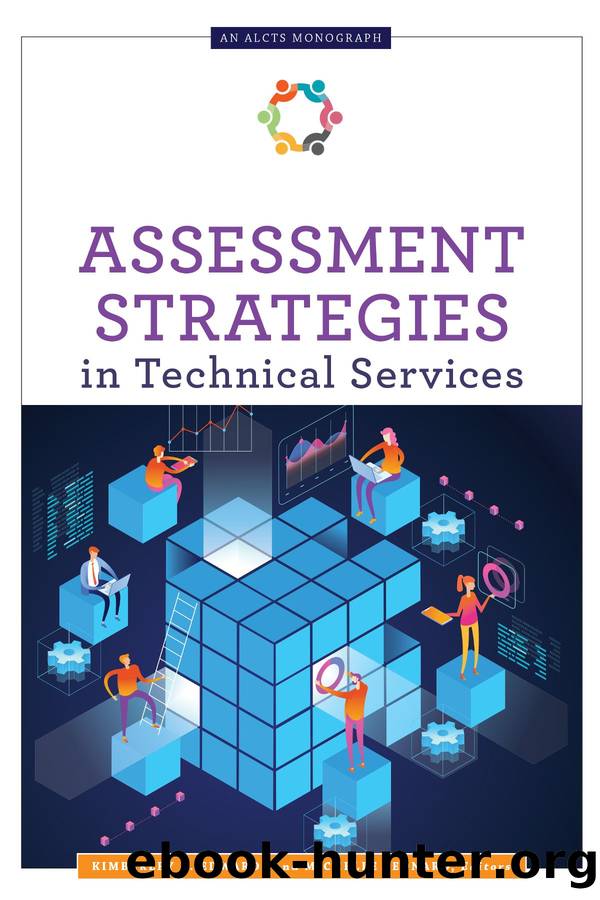Assessment Strategies in Technical Services by Kimberley A. Edwards Michelle Leonard (2019)

Author:Kimberley A. Edwards, Michelle Leonard (2019)
Language: eng
Format: epub
Tags: LAN025000 Language Arts & Disciplines / Library & Information Science / General
Publisher: American Library Association
Asking for Feedback
You should reach out to all librarians and the stakeholder groups that have been identified early in the assessment project. The goal of this phase should be to gather the qualitative information about serials to complement the quantitative data provided by the project team. The importance of feedback from patron groups cannot be understated. This phase is typically marked by a flurry of e-mails and spreadsheet exchanges. Whether intentional or not, there will be more versions of spreadsheets than desired. Librarians reviewing titles will want their own copies to work from. Rather than fight against this, be clear from the outset how people should submit feedback. The master title spreadsheet could include columns for each reviewerâs recommendation, or separate lists could be sent to review. Three things are key to communicate: when the feedback is due, how it should be submitted, and who has final decision-making authority.
Soliciting feedback from library colleagues is a relatively straightforward matter. For external stakeholders, like faculty, a variety of channels for receiving feedback can be used. The most effective choice for a library will depend on how the faculty are consulted in typical collection development decisions. Much will depend on the relationship between the faculty and the library. The library may rely on a faculty advisory board to review decisions. There may be a faculty representative designated to work with the library on collection issues for their department. The subject librarian may attend the departmentâs (or collegeâs) faculty meeting. The consultation may happen purely over e-mail, or through feedback forms on the libraryâs web page. The form of the consultation need not be the same for every stakeholder group. Use as many channels of communication as necessary to get the responses the library requires to proceed.
A public comment period can be left open for anyone to advocate for a resource on the libraryâs website, or the comments can be submitted through subject librarians. For the former, a feedback mechanism on the website can be created to allow individuals to advocate for a title.20 However feedback is to be managed, be sure to leave enough time for the project team to review and respond to the feedback before coming to a final decision for each title.
But what does feedback look like? The evaluative criteria selected by the project team is a good place to start. You should refer to the strategies and metrics identified in Phase 1, and identify what information the project team does not have and who can provide it. Subject liaisons possess both deep disciplinary knowledge and an intimate familiarity with library resources. They can help identify whether the content is available elsewhere or the subject matter is adequately covered by another title. Even though usage statistics are helpful in determining need, they are not always the most reliable source of information for demonstrating this need. Often it is up to librarians to assess whether or not a journal is truly vital to support the research interests of students, faculty, and staff at the university.
Download
This site does not store any files on its server. We only index and link to content provided by other sites. Please contact the content providers to delete copyright contents if any and email us, we'll remove relevant links or contents immediately.
Phoenicians among Others: Why Migrants Mattered in the Ancient Mediterranean by Denise Demetriou(577)
Verus Israel: Study of the Relations Between Christians and Jews in the Roman Empire, AD 135-425 by Marcel Simon(576)
Caesar Rules: The Emperor in the Changing Roman World (c. 50 BC â AD 565) by Olivier Hekster(558)
Europe, Strategy and Armed Forces by Sven Biscop Jo Coelmont(504)
american english file 1 student book 3rd edition by Unknown(481)
Give Me Liberty, Seventh Edition by Foner Eric & DuVal Kathleen & McGirr Lisa(469)
Banned in the U.S.A. : A Reference Guide to Book Censorship in Schools and Public Libraries by Herbert N. Foerstel(468)
The Roman World 44 BC-AD 180 by Martin Goodman(458)
Reading Colonial Japan by Mason Michele;Lee Helen;(457)
Basic japanese A grammar and workbook by Unknown(456)
DS001-THE MAN OF BRONZE by J.R.A(443)
The Dangerous Life and Ideas of Diogenes the Cynic by Jean-Manuel Roubineau(440)
Introducing Christian Ethics by Samuel Wells and Ben Quash with Rebekah Eklund(433)
Imperial Rome AD 193 - 284 by Ando Clifford(432)
The Oxford History of World War II by Richard Overy(432)
Literary Mathematics by Michael Gavin;(392)
Language Hacking Mandarin by Benny Lewis & Dr. Licheng Gu(380)
Catiline by Henrik Ibsen--Delphi Classics (Illustrated) by Henrik Ibsen(369)
How to Reach the 9.0 in IELTS Academic Reading by IELTS Medical(358)
